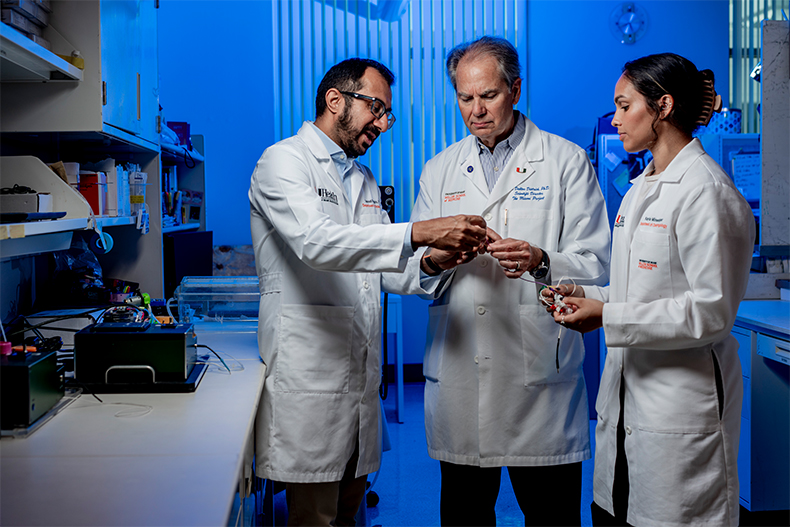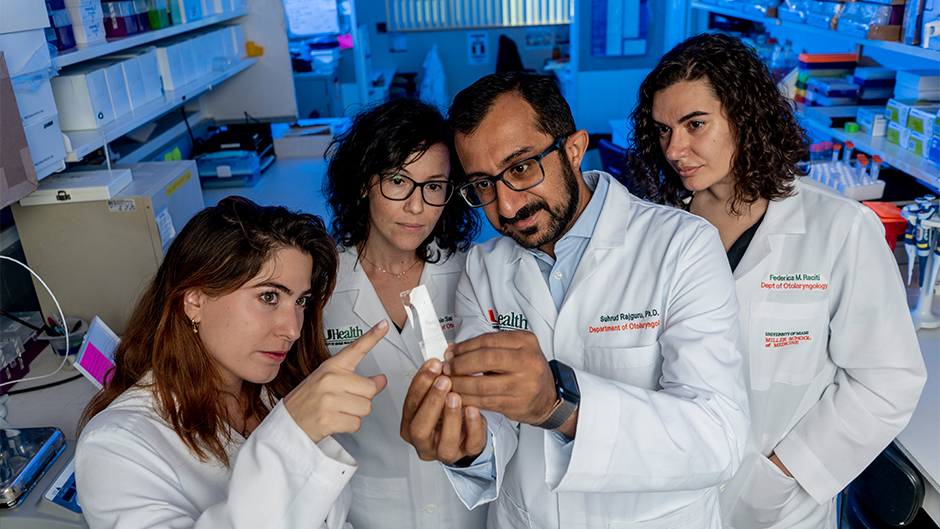Offered in collaboration with the Miller School of Medicine, the M.S. and B.S./M.S. programs focus on challenging issues, such as robotic movement systems, bioengineered materials, the brain-computer interface, and treatments for neural degenerative conditions like Alzheimer’s disease.
“With these exciting programs and the support of industry partners, our Neural Engineering Initiative is well-positioned for leadership in this field,” said Pratim Biswas, dean of the College of Engineering. “We are looking forward to recruiting and training the next generation of professionals seeking to improve the functioning and well-being of people with traumatic injuries or chronic disorders of the brain and central nervous system.”
“A special feature of these two programs is that they were deliberately designed to provide a pathway for both engineers and non-engineers to receive advanced training in neural engineering," said Fabrice Manns, professor and chair of the Department of Biomedical Engineering. "These are great examples of innovative engineering programs that break the traditional academic disciplinary barriers.”
Launching the programs
The first cohort of four students in the M.S. neural engineering program began their studies this fall, according to program director Suhrud Rajguru, Ph.D., professor, Biomedical Engineering & Otolaryngology; co-director, Institute for Neural Engineering; and director, Miami Clinical and Translational Science Institute (CTSI) Workforce Development.
"Our two-year M.S. program allows students from diverse backgrounds in engineering and science to learn from each other and from faculty who are engaged in cutting-edge research in translational neuroscience and neural engineering. Students receive hands-on training in a supportive environment that spans multiple schools and colleges," said Rajguru. “We expect the program to grow to 15 or more students next year.” The five-year B.S./M.S. program – which will begin in the fall 2023 semester – allows students to earn an undergraduate degree in engineering, biology, computer science, physics, mathematics or neuroscience, followed by a master’s degree in neural engineering.
“Our industry partners appreciate that our students are prepared beyond technical and scientific skills through a rigorous curriculum with a focus on critical thinking, communication, problem solving, ethics, and working in a team environment,” added Rajguru. “Development of novel technologies to address major clinical challenges across diverse patient populations requires a workforce with different voices and experiences.”
Meeting a growing need
With advances in robotics, sensory devices, nanotechnology, software applications, and diagnostic tools, neural engineers are in high demand, said program co-director W. Dalton Dietrich, Ph.D., professor, Neurological Surgery; scientific director of the Miami Project; co-director, Institute for Neural Engineering; and University of Miami senior associate dean for discovery science.
“We need well-trained multidisciplinary professionals who can address challenging acute and more progressive injuries to the central nervous system,” said Dietrich. “We also require sensitive diagnostic approaches to measure risk factors and take a proactive approach to targeting and treating neurodegenerative diseases. Neural engineering will be even more important in the next decade with the steady increase in our older population.”

At the Miami Project to Cure Paralysis, Dietrich and colleagues are advancing interdisciplinary strategies for improving function and quality of life for people with spinal cord and brain injuries, stroke, and other serious conditions. “At the Miller School of Medicine, we investigate biological therapies for neurological disorders using cell therapies and the identification of novel compounds to enhance brain circuit function including axonal regeneration,” said Dietrich. “Neural engineers are adding an important new dimension to regenerative medicine with brain stimulation devices for activating brain circuits, robotic systems to enhance rehabilitation protocols, novel biomaterials to promote healing, and other advancements. The merging of biologic and engineering approaches has great potential for helping many people living with disabilities and other neurological conditions.”
A collaborative approach
Rajguru said the M.S. and B.S./M.S. programs are the next step forward for the Institute for Neural Engineering, adding to its critical mass of biomedical scientists, clinicians, engineers, and trainees. “Neural engineering students can take advantage of a wide range of resources across the university, including institutes and centers that focus on nanotechnology, data sciences, human genomics, and marine biology, as well as the College’s MakerSpace, Johnson & Johnson 3D Printing Center of Excellence Collaborative Laboratory, and associated facilities in material characterization, advanced computing, instrumentation, and biomaterials.”
Neural engineering students can translate therapeutic discoveries and inventions into commercial applications and bring them to patients, families, and large populations, with help from Miami Engineering, Miami CTSI, and the University. “We also help our industry partners advance and refine their technologies, such as prototype devices for specific patient populations,” Dietrich said. “When we look at what we can accomplish by bringing engineering and medical innovation together, the sky is the limit.”

